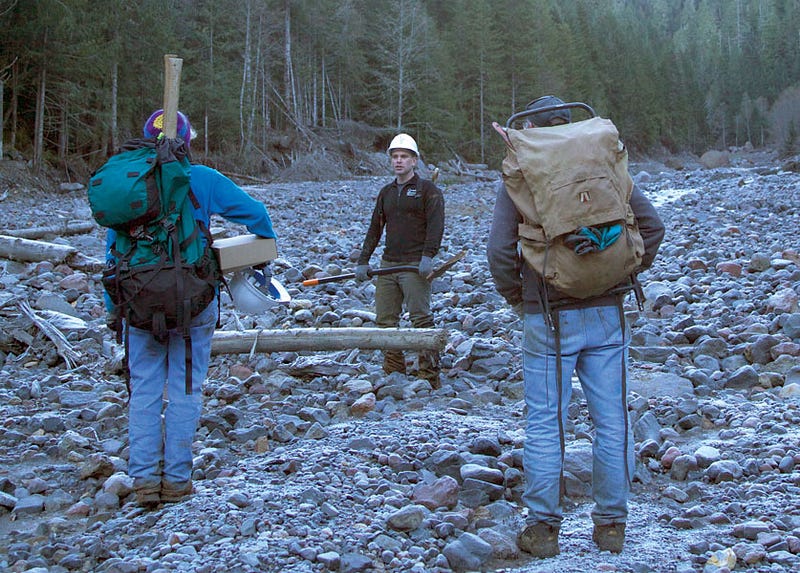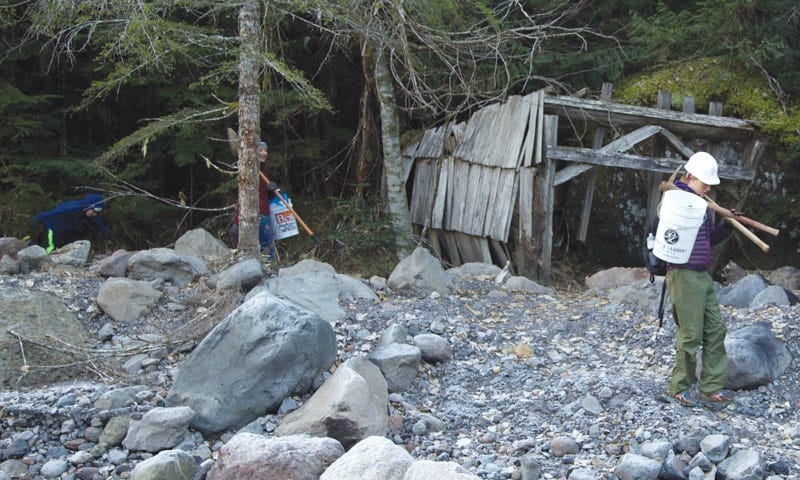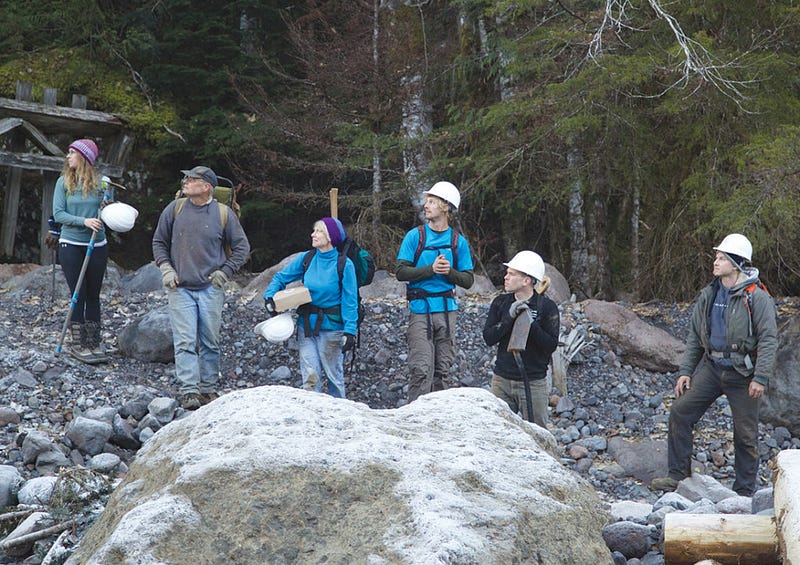Running Into The Past
STORY BY ALEXANDRA WITHROW
photos by Annmarie Kent
The revival of a 100-year-old adventure marathon
Forty-eight hours and 17 minutes of willpower and determination. Forty-eight hours and 17 minutes of running, sweating and climbing. Forty-eight hours and 17 minutes with almost no sleep. On Aug. 1, 2014, three men ran from Bellingham Bay to the top of Mount Baker and back in 48 hours and 17 minutes.
The group left Cornwall Beach at noon and didn’t reach the Ridley Creek trailhead to begin their hike up the mountain until after midnight. This was the fourth attempt to follow the path of the Mt. Baker Marathon, a train, car and foot race that began in 1911 and ended in 1913. Their run eliminated the car and train portions of the marathon, instead the run is done entirely on foot.
RUNNING MAN
Daniel Probst spearheaded the two-day, 100-mile run. Inclement weather and the difficulty of the run had sent him home three times before. The top of Mount Baker is covered in snow and ice late into the summer causing a blinding glare from the sun. A lightning storm struck during one of his attempts, and the group could feel the buzz of electricity in their metal ice axes.
Probst’s goal is to revive the historic Mt. Baker Marathon and turn it into a new and improved ultramarathon through his nonprofit organization, the Cascade Mountain Runners.
The marathon has garnered attention from a variety of sources over the past several months including the Bellingham Herald, Trail Runner and Adventures NW.
Over the last 10 years, Probst has run about 40 ultramarathons set all over the world. These races are not for the faint of heart. An ultramarathon has to be at least 26.2 miles long, and Probst prefers races that are much longer. During a 200-mile race in Italy, he only slept for seven hours over the course of five days, he says.
“Running 100 miles is never easy. It gets easier, but it’s never easy, and you never know if you’re going to finish when you start,” he says. “It’s kind of a metaphor for life, you’ve got to start things that you don’t know if you can finish.”
His current challenge is getting the Mt. Baker Marathon ready to run by June 2015. This means fundraising, attaining permits and finding volunteers to help him rebuild the Ridley Creek Trail, one of the paths used in the original marathon, he says.
But the run is always worth it. The sense of camaraderie among participants and the emotional benefits of being out in the woods inspire Probst to continue on this path and restore the Mt. Baker Marathon, he says.

“This weekend we were on the side of a snow-covered mountain, with a 1,000 foot drop down to the tree-line, in super slick conditions and we we’re all watching out for each other,” he says. “It’s what makes you feel alive and you crave that.”
The marathon has its roots in Bellingham, which is another reason Probst wants to revive it. “This felt like the right race to bring back because it’s got all this history here that’s part of the race,” he says.
A RACE THROUGH HISTORY
Todd Warger, local historian, author and documentary filmmaker, recently codirected a film about the original Mt. Baker Marathon, entitled “The Mountain Runners.” The film has won a collection of awards in addition to receiving two Emmy nominations.
The Mt. Baker Marathon began as a way to attract tourism to Bellingham at the turn of the century. It was the United States’ first “adventure race,” a sport that has evolved into the ultramarathon. The racers ranged from professional runners to coal miners, from bedspring makers to postmen, Warger says.
The race consisted of taking either a car or a train from Bellingham Bay to one of two trailheads, running to the top of Mount Baker, running back to the vehicle then driving back to Bellingham, Warger says. The runners had the option of taking the 32-mile round-trip trail that began in Deming or the steeper 28-mile trail that started in Glacier.
The cars and trains were then stripped down to their bones to make them lighter and faster, supposedly giving those racers an advantage. The runners would drive through treacherous roads with streams of muddy water trailing down the sides, and conditions were hardly better for the trains, Warger says.
“A lot of the runners said the transportation was worse than the run because it was so dangerous and they felt more out of control,” he says.
For the first two years of the marathon, the race would start at night so the snow on Mount Baker would still be packed and firm in the morning when runners reached the mountain, Warger says. The men were forced to carry jerry-rigged lanterns made from buckets filled with lard and candles as they smashed through the muddy trails.
Out of the 37 men who participated in the three marathons, only 12 completed the race, he says.

Rules changed in 1913, and the marathon began in the morning that year to allow more spectators to see the race, Warger says. This resulted in two men falling into mountain crevasses due to the low visibility at night.
The race didn’t go on after 1913 for several reasons. The spectators saw the marathon as a kind of “human horse race,” where wealthy entrepreneurs exploited less well-to-do citizens into running in the treacherous marathon for the prize money at the end, he says.
J.J. Donovan, a timber and railroad tycoon based in Bellingham, felt the race reflected poorly on the area. The Panama Canal would be built in 1914 and Donovan knew he needed the world to take him, and his town seriously, if he wanted his ships and lumber to succeed in this emerging market.
“Whatever J.J. Donovan said, people listened,” Warger says. “If he said ‘This is done’ and he’s not going to support it anymore, then everybody else backed out too.”
The race organizers went bankrupt and the marathon was over.
“It wasn’t just a race, there was a lot of interest in nature and going back to the mountains,” Warger says. “I think locally it’s interesting how those feelings and those emotions about ‘The mountains in the backyard’ haven’t changed.”
BACK TO THE STARTING BLOCK
Aaron Poh ran alongside Probst last summer as his first successful ultramarathon. He had attempted the run once in June but failed to reach the summit of Mount Baker.
The two met through Fairhaven Runners, a local running group that holds weekly runs, Poh says. He had expressed interest in the marathon but was shocked when Probst extended an invitation to do the trial run with him last August.
“I was super stoked about it, super excited, but I was also like ‘Do you really think I can do this?’” he says. “He had faith in me, so I felt reassured that I would be able to.”
He had previously completed the Chuckanut 50k and a few other long-distance runs, but had never attempted anything like the grueling 100-mile marathon, he says.

The marathon was challenging for many reasons. Large cedar trees, 3 to 4 feet in diameter, which had fallen across the overgrown path, blocked their way. The men were carrying large packs and an array of climbing gear, and midway up the mountain they began to run out of water, Poh says.
“It was super hot on the mountain. I knew it was going to be hot, but I was amazed by the reflection of the sun on the snow,” he says. “I was just pouring sweat the whole time.” Poh was concerned about the threat of dehydration, but he knew panicking would be an unnecessary blow to morale, he says.
The runners in the original marathon in the early 1900s would have faced these same conditions, yet many were still able to complete the race.
“When I was going up the Ridley Creek trail I was just amazed that people were doing this 100 years ago,” Poh says. “I think it’s important to pay tribute to the people that founded our area — it’s easy to overlook how this town was built and how it came to be.”
Whether in 1911 or 2014, the Mt. Baker Marathon has attracted runners from all walks of life because of these challenges, not in spite of them.
The marathon has been able to transcend time and overcome barriers for more than 100 years. Humans have an innate companionship with the outdoors, and no amount of distance or time will be able to alter this bond.
